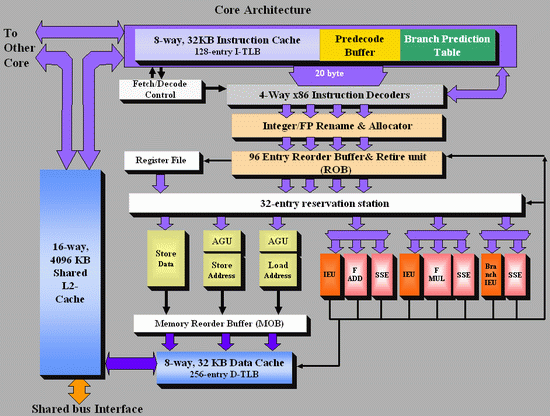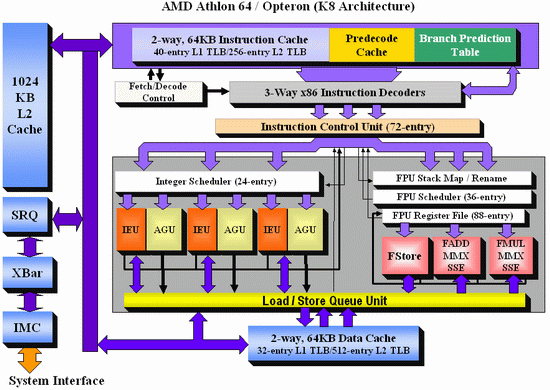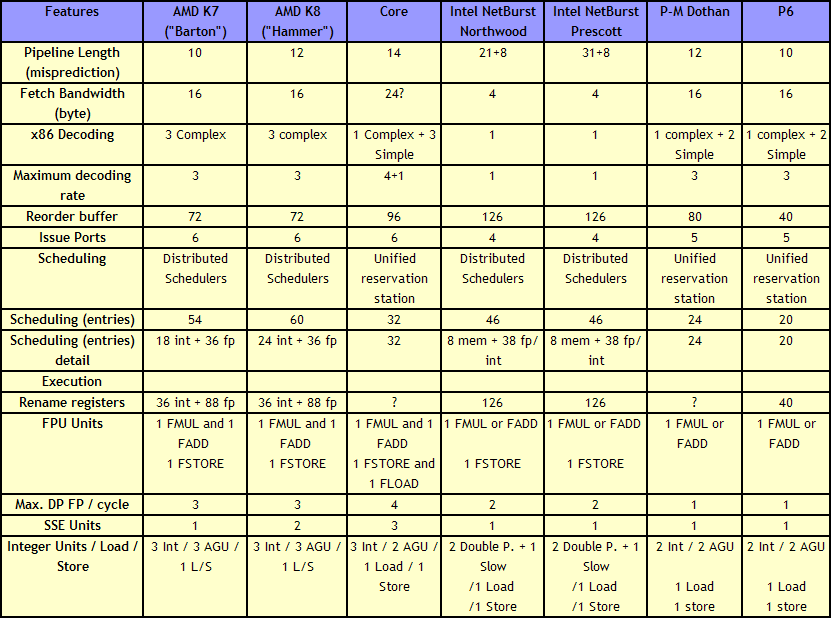Ten Year Anniversary of Core 2 Duo and Conroe: Moore’s Law is Dead, Long Live Moore’s Law
by Ian Cutress on July 27, 2016 10:30 AM EST- Posted in
- CPUs
- Intel
- Core 2 Duo
- Conroe
- ITRS
- Nostalgia
- Time To Upgrade
Core: Out of Order and Execution
After Prefetch, Cache and Decode comes Order and Execution. Without rehashing discussions of in-order vs. out-of-order architectures, typically a design with more execution ports and a larger out-of-order reorder buffer/cache can sustain a higher level of instructions per clock as long as the out-of-order buffer is smart, data can continuously be fed, and all the execution ports can be used each cycle. Whether having a super-sized core is actually beneficial to day-to-day operations in 2016 is an interesting point to discuss, during 2006 and the Core era it certainly provided significant benefits.
As Johan did back in the original piece, let’s start with semi-equivalent microarchitecture diagrams for Core vs. K8:
For anyone versed in x86 design, three differences immediately stand out when comparing the two. First is the reorder buffer, which for Intel ranks at 96 entries, compared to 72 for AMD. Second is the scheduler arrangement, where AMD uses split 24-entry INT and 36-entry FP schedulers from the ‘Instruction Control Unit’ whereas Intel has a 32-entry combined ‘reservation station’. Third is the number of SSE ports: Intel has three compared to two from AMD. Let’s go through these in order.
For the reorder buffers, with the right arrangement, bigger is usually better. Make it too big and it uses too much silicon and power however, so there is a fine line to balance between them. Also, the bigger the buffer it is, the less of an impact it has. The goal of the buffer is to push decoded instructions that are ready to work to the front of the queue, and make sure other instructions which are order dependent stay in their required order. By executing independent operations when they are ready, and allowing prefetch to gather data for instructions still waiting in the buffer, this allows latency and bandwidth issues to be hidden. (Large buffers are also key to simultaneous multithreading, which we’ll discuss in a bit as it is not here in Core 2 Duo.) However, when the buffer has the peak number of instructions being sent to the ports every cycle already, having a larger buffer has diminishing returns (the design has to keep adding ports instead, depending on power/silicon budget).
For the scheduler arrangements, using split or unified schedulers for FP and INT has both upsides and downsides. For split schedulers, the main benefit is entry count - in this case AMD can total 60 (24-INT + 36-FP) compared to Intel’s 32. However, a combined scheduler allows for better utilization, as ports are not shared between the split schedulers.
The SSE difference between the two architectures is exacerbated by what we’ve already discussed – macro-op fusion. The Intel Core microarchitecture has 3 SSE units compared to two, but also it allows certain SSE packed instructions to execute within one instruction, due to fusion, rather than two. Two of the Intel’s units are symmetric, with all three sporting 128-bit execution rather than 64-bit on K8. This means that K8 requires two 64-bit instructions whereas Intel can absorb a 128-bit instruction in one go. This means Core can outperform K8 on 128-bit SSE on many different levels, and for 64-bit FP SSE, Core can do 4 DP per cycle, whereas Athlon 64 can do 3.
One other metric not on the diagram comes from branch prediction. Core can sustain one branch prediction per cycle, compared to one per two cycles on previous Intel microarchitectures. This was Intel matching AMD in this case, who already supported one per cycle.













158 Comments
View All Comments
Nameofuser44 - Wednesday, August 3, 2016 - link
Here I thought I was the only slow poke to not give up my C2D (4300) & ATI 5770 / 2GB ram /as a daily driver. Well here's to ten wonderful years!rarson - Thursday, August 4, 2016 - link
I'm still using a Core 2 Duo E8600 in my desktop. In an Abit P-35 Pro motherboard. The damn thing just works too well to get rid of, and I love the Abit board.rarson - Thursday, August 4, 2016 - link
Durr, it's the IP35 pro, P35 chipset.skidaddy - Friday, August 5, 2016 - link
My 10 year old E6600 with EVGA board & EVGA/NVIDIA 295 video card is also a great space heater. CUDA on card extended utility of set up. Only limitation is no CPU video decoding limits streaming to 1440. Waiting for the Intel Kaby Lake or better on die Intel GPU to be able to handle 4K @ 60fps over HDMI not USB3(+).BoberFett - Friday, August 5, 2016 - link
I'm still rocking my C2D E6500. It does the job.johnpombrio - Friday, August 5, 2016 - link
The Core 2 architecture was developed in Israel by a Intel team working on mobile processors. Intel suddenly realized that they had a terrific chip on their hands and ran with it. The rest is history.http://www.seattletimes.com/business/how-israel-sa...
FourEyedGeek - Monday, August 8, 2016 - link
How do you think one of those first Core processors would fare if fabricated at Intels 10nm process?Could they lower voltage or increase performance significantly?
Visual - Monday, August 8, 2016 - link
So a 10 year old chip is about half the performance of today's price equivalent. I'd have hoped today's tech to be more like 10 times better instead of just 2.